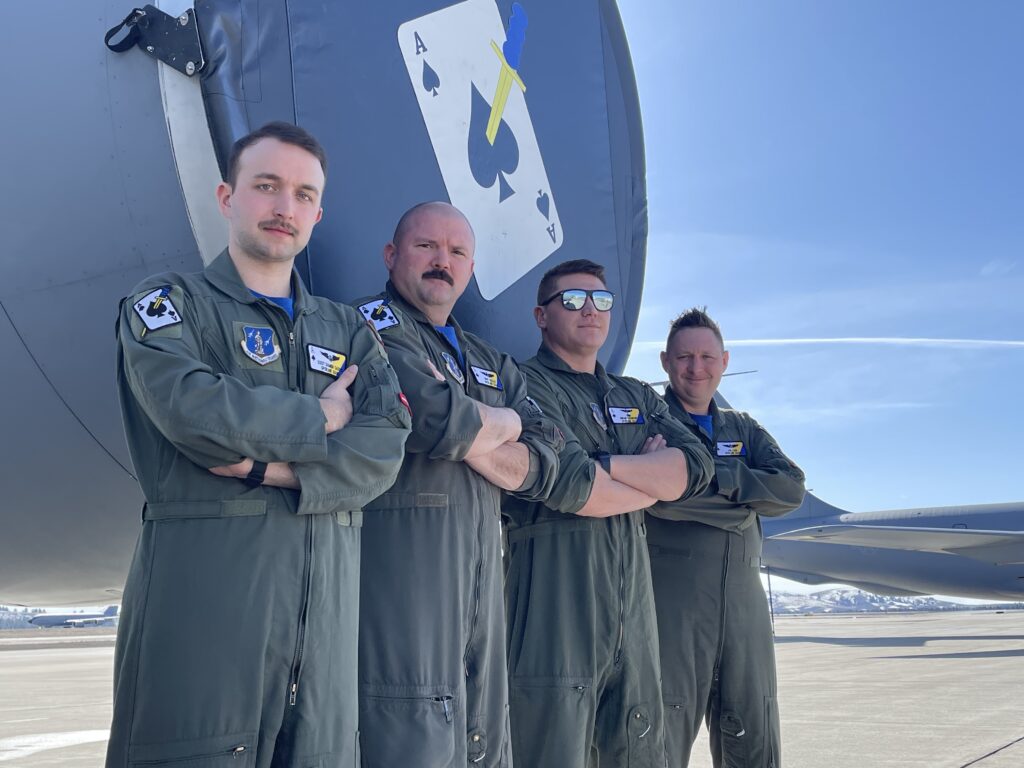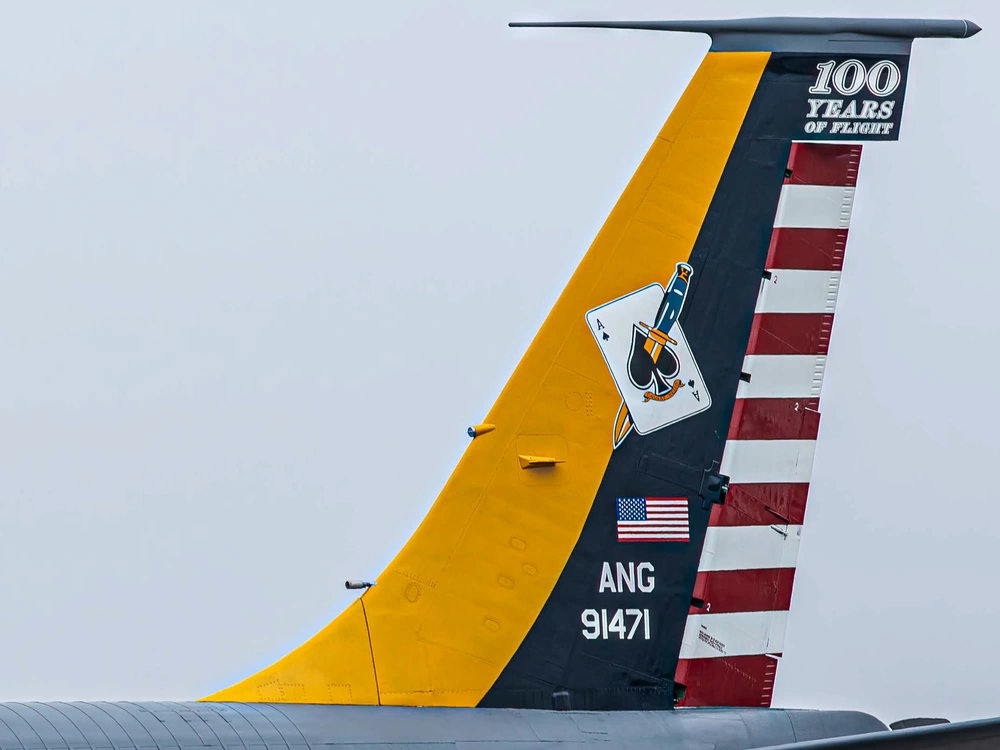The 116th Air Refueling Squadron of the Washington Air National Guard got its start in Spokane 100 years ago and since then multiple generations of the same families have called the unit home and flown or fixed its airplanes.
The unit actually got its start even earlier, in 1920, when the aviation committee of the Spokane Chamber of Commerce to talk about the possibility of getting an Air National Guard unit in the city. Enthusiasm was strong and early supporters convinced the city of Spokane to lease them the old Parkwater Municipal Golf Course to create an airfield that would later become Felts Field.

In 1924 word came that there would be one Air National Guard Unit in Washington State, and whichever city could raise $10,000 first would get it. Weeks of frantic effort followed. The Spokane Chamber of Commerce raised $5,000, the Spokane County Commissioners contributed $2,500 and the Spokane City Council gave $2,500. Spokane had beat out Seattle and Tacoma for the rights to the first Air National Guard unit in Washington State.
“The city and the folks who wanted it fought tooth and nail,” said Major Brit Quigley, a pilot in the 116th for the last 25 years.
On August 6, 1924, the 116th Observation Squadron was created. Historically, however, the unit was a reorganization of the 116th Aero Squadron, which was created in 1917 and began serving in France later that year. It, in turn, was redesignated the 637th Aero Squadron (Supply) in early 1918. The unit remained there until the end of World War I in November 1918.
The first commander of the 116th was retired Army veteran and wheat farmer John T. Fancher, who had served as a pilot and air combat unit commander in World War I. He had been actively involved in the creation of the 116th and soon set about creating the unit from scratch.
Stories have been told about the first airplanes that would arrive in Spokane, three Curtis JN6-A2 “Jennys.” They came by train in giant boxes and had to be assembled, Quigley said. “They didn’t have oil and they went around the city getting samples of oil,” he said.
They also didn’t have gas, and one of the unit members used his own money to buy 15 gallons of gas, Quigley said.
Current members of the 116th appreciate the unit’s early history. “That grit and that determination in that story is what makes Spokane so special,” said Major Brian Kranches.
“The people who started that were a special breed,” said Quigley.

Graphic artist Steve Grime was a pilot in the 116th before he retired in 2016. He went to Eastern Washington University to earn a degree in graphic design after he retired. His former unit commanders, knowing that, reached out to him to see if he was willing to design a special logo and other items for the unit’s 100th anniversary. He was happy to do so. “You only get a centennial once,” he said.
One of the things he designed was art for the tail of the giant KC-135 tankers that he used to fly. He was inspired by designs used on the unit’s planes in the 1930’s. “Spokane aircraft, specifically at Felts Field, had that kind of design.”
The design includes solid vertical swaths of yellow and black paint as well as a section with red and white stripes. “100 Years of Flight” is emblazoned on the tip of the tail. Also featured prominently is the unit’s insignia, an Ace of Spades playing card with a dagger thrust through the middle. The tail design is on only one plane.
“They had to go through serious bureaucratic hurdles just to get it painted on an airplane,” he said.
There is, of course, a story about the creation of the unit insignia. As the story goes, members of the unit were having a late night poker game in 1931 when the topic of an insignia came up. Lt. Laurie Heral tossed an ace of spades on the table and said it was known as the “death card.” Everyone liked the idea of using the ace of spades, but Heral thought it was missing something. He took out a dagger and impaled the card through the center, suggesting that the dagger gave it more impact. That was the birth of the “ace and dagger” unit insignia that is still in use today.

Grime also designed a poster, stamp and a logo that can be put on t-shirts and coins. “They’ll have swag to sell at airshows,” he said.
Grime served for 27 years, spending the last 10 as a tanker pilot in the 116th. Prior to that he was a helicopter pilot in a rescue unit. “It’s like going from a Ferrari to a Mack truck,” he said of the differences between the two types of aircraft. “It’s a large aircraft and it’s not as nimble as a helicopter.”
He said he is pleased to be a part of the unit’s 100th anniversary celebration. “A rich history of Spokane runs through that unit,” he said. “It was a good unit. We certainly traveled the world, to some great parts and not so great parts.”
Major Jon Cael is a fourth-generation member of the 116th. His great-grandfather was the first to serve and he grew up hearing stories from his grandfather and how happy he was to be part of the unit. As a child, he would accompany his father when he had drill weekends and play football with other kids who came along.
Being a member of the Air National Guard was something he was steeped in. “I just remember back to my dad going off to Desert Storm,” Cael said.
Like his father, grandfather and great-grandfather before him, Cael got his start in aircraft maintenance. But he is the only member of the family to move on to become a pilot. He wanted to serve in the Air National Guard instead of the Air Force because he had no interest in being transferred to a new posting every few years.
“I wanted to be home,” he said. “I wanted Spokane to be home. I have a lot of roots here.”
His father is now retired, but the two did get an opportunity to deploy together before that. “It was cool,” Cael said. “Being able to work with him on the flight line and having him launch me out was so cool.”
Staff Sergeant Damen Gaddis is a boom operator and has been with the 116th for six years. He’s a second-generation member of the unit and his father still serves in the unit. “I enlisted in the Guard when I was 17 years old,” he said.
As the years went by and planes changed, so did the mission of the 116th. During World War II the unit did submarine patrols along the west coast for a time. It was known as the 116th Fighter Squadron when activated during the Korean War. In the late 1950’s it became a fighter interceptor squadron. When the KC-135 Stratotankers arrived in 1976, the unit moved from Geiger field, where it had been since the late 1940s, to Fairchild Air Force Base.
The 116th squadron is part of the 141st Air Refueling Wing, commanded by Col. James McGovern. The wing used to be classified as a “ready reserve” unit, which was only to be activated in cases of high need, McGovern said. It’s now classified as an operational wing.
“Now we’re just like the active duty, but a large portion of our unit is part-time,” McGovern said. “We fly every day. We refuel all the conventional aircraft.”
As a National Guard unit, the 116th has a dual mission, McGovern said, Federal and domestic. Most of what they do is considered federal, refueling aircraft wherever and whenever needed. In domestic operations, they can assist states with their needs.
As an example, McGovern points to the National Guard response to the January 6, 2021 riot in Washington, D.C. The 116th not only supplied fuel to planes transporting Army National Guard troops to D.C., they flew some of the troops themselves. In total, pilots from the 116th flew 37 flights. “The numbers were just astounding,” McGovern said. “We stand in the ready to help the states.”
It’s not unusual for members of the 116th and 141st to be deployed around the world. There are currently a little more than 100 members deployed and once they return in April, another hundred will take their place, McGovern said.
He said he’s impressed by the skill and dedication shown by members of his air wing, most of whom have day jobs. “These are airline pilots, electricians,” he said. “We used to have a school teacher.”
It’s not unusual for members of the 116th to spend decades in the unit before retiring. They see themselves as a family, forming bonds strengthened because they aren’t constantly transferring to the next post.
“It’s the Guard family,” Quiqley said. “It’s kind of embedded in our culture. We all band together and take care of each other in good times and bad.”
The Guard family will have more chances to celebrate the unit’s 100-year history, including during a special picnic held during the August drill weekend, McGovern said. Former and current members of the unit will also be invited to a gala on August 9.
“We’re one of 12 flying units in the country to reach their centennial,” McGovern said. “It’s a pretty big deal for the airmen.” In the meantime, residents can keep a lookout for the KC-135 with the special tail art in the sky over the West Plains. “That plane is what we consider our flagship,” McGovern said. “That’s the one we can actually have nose art on. It’s our baby.”



